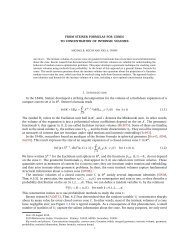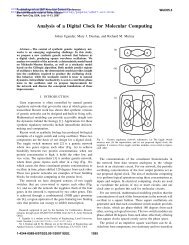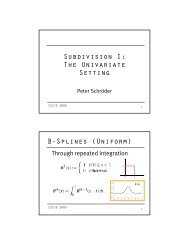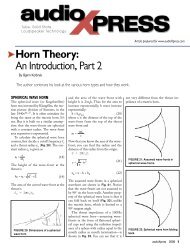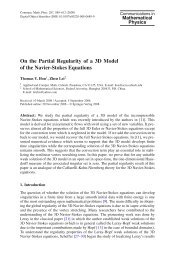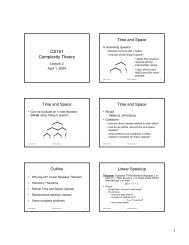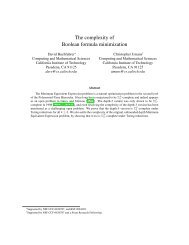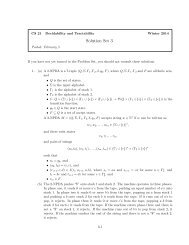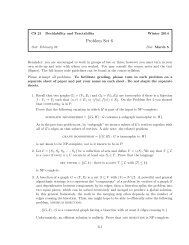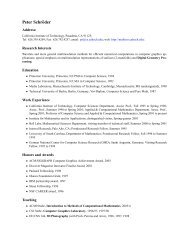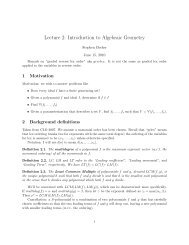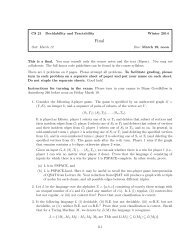Removing the Stiffness from Interfacial Flows with Surface Tension
Removing the Stiffness from Interfacial Flows with Surface Tension
Removing the Stiffness from Interfacial Flows with Surface Tension
Create successful ePaper yourself
Turn your PDF publications into a flip-book with our unique Google optimized e-Paper software.
332 HOU, LOWENGRUB, AND SHELLEYtwo pieces of <strong>the</strong> interface are drawn toge<strong>the</strong>rl This jet is 0.2recognized in that <strong>the</strong> approaching parts of <strong>the</strong> interfacecome <strong>with</strong> oppositely signed vortex sheet strengths, and<strong>the</strong>ir signs are such that fluid flows into <strong>the</strong> fingers. For thisinitial data (single-signed sheet strength), such a sign 0change in <strong>the</strong> vortex sheet strength can only occur in <strong>the</strong>presence of surface tension.Figure 12 shows <strong>the</strong> unnormalized vortex sheet strength,~, versus 0~. Recall that y, initially, is not identically equal to1 as it has been rescaled appropriately for <strong>the</strong> 0- L frame.In this frame, <strong>the</strong> unnormalized vortex sheet strength differs<strong>from</strong> <strong>the</strong> true vortex sheet strength (i.e., <strong>the</strong> tangential jump 0in velocity) by only <strong>the</strong> time-dependent scale factor L/2zc. Atearly times, two positive peaks form in <strong>the</strong> vortex sheet 20ostrength (see box (b)). These are <strong>the</strong> remnants of <strong>the</strong> S = 0,Kelvin-Helmholtz instability, which concentrates vorticity 0into <strong>the</strong> center. In <strong>the</strong> S = 0 case, <strong>the</strong>re is only one peak[31] but <strong>the</strong> addition of a small surface tension splits it in -20%two. There are small waves that form at <strong>the</strong> outer edges of<strong>the</strong>se peaks and are presumably dispersive waves producedby <strong>the</strong> surface tension saturation of <strong>the</strong> Kelvin-Helmholtzinstability. At t = 0.80 (box (e)), <strong>the</strong> peaks have saturatedand more waves have been produced. These disperseoutward along <strong>the</strong> interface. The strength ? has also formeddownward peaks at <strong>the</strong> edge of <strong>the</strong> wave packet. The saturationand dispersion continues through t--1.20 (box (f)).However, when <strong>the</strong> interface begins to self-approach, <strong>the</strong>vortex sheet strength refocusses, forming <strong>the</strong> jet. By <strong>the</strong> finaltime t = 1.40 (box (e)), two pairs of positive and negativepeaks of vortex sheet strength have formed in each pinchingregion. These peaks have been isolated for <strong>the</strong> top pinchingregion in box (f). The top of <strong>the</strong> pinching region (inner turnof <strong>the</strong> spiral) comes <strong>with</strong> a negative signed vortex sheetstrength and <strong>the</strong> bottom comes <strong>with</strong> a positive sign. Thisimplies that fluid is streaming through <strong>the</strong> gap towards <strong>the</strong>center and into <strong>the</strong> downward pointing finger.Saturation and refocussing is also observed in <strong>the</strong> curvature.Its evolution is plotted in Fig. 13. The first graphshows <strong>the</strong> inverse maximum of <strong>the</strong> curvature (in absolutevalue) as a function of time. There is an initial region ofrapid growth in <strong>the</strong> curvature (decrease in <strong>the</strong> plot) due to<strong>the</strong> S = 0 Kelvin-Helmholtz instability. Recall that for <strong>the</strong>Kelvin-Helmholtz singularity, <strong>the</strong> curvature diverges. Here,<strong>the</strong> curvature saturates and eventually refocusses. By <strong>the</strong>final time t = 1.40, <strong>the</strong> maximum of <strong>the</strong> curvature nearly ~reaches that attained during <strong>the</strong> initial period of growth. 4The refocussing, however, occurs at different places along<strong>the</strong> interface as seen in <strong>the</strong> o<strong>the</strong>r plots of t¢ versus ~. Disper- 2sive waves are also generated and move outwards along <strong>the</strong>interface. At t = 1.40, <strong>the</strong> pinching points are indicated bypairs of like-signed peaks in <strong>the</strong> curvature.Evidence is now presented to show that <strong>the</strong> pinchingtakes place in a finite time. Maintaining resolution is criticaland so <strong>the</strong> neck widths obtained <strong>from</strong> different spatial and0.I ~ , ~i1c8Inverse Curvanu~, (a)0.5 ITCurvature, (c)-200 . . . .0.2 0.4 0.6 0.8T=0.60Curvature, (e)J ~0.2 0.4 0.6 0.8T=l.201.5Curvature, (b)-200~ 0.2 0.4 0.6 0.8T=0.40Curvature, (d)-2000 0.2 0.4 0.6 0.8T=0.800Curvature, (O2o00 o~ o-q" o-g o-~T=I.40FIG. 13. Inertial vortex sheet: sequence ofx vs. a; S = 0.005, N= 1024,A t = 1.25 x 10 - 4: (a) plot of inverse maximum curvature (absolute value ):(b) plot of curvature, t=0.40; (c) t=0.60; (d) t=0.80; (e) t= 1.20;(f) t= 1.40.temporal resolutions are compared. This is shown in <strong>the</strong> topgraph of Fig. 14, which shows minimum width in <strong>the</strong> toppinching region, graphed as a function of time starting att = 1.40. As in <strong>the</strong> Hele-Shaw case, <strong>the</strong> minimum width iscomputed by minimizing <strong>the</strong> distance function betweeneach piece of <strong>the</strong> interface and using <strong>the</strong> Fourier interpolant1.4x 10 -3Minimum Distance to Pinching, (a).. 1024-- 2048-.- 4096- 81921.405 1.41 1.415 1.42 1.425 1.43 1.435TNumber of Accurate Digits in Energy, (b)- 2048 ............................... - ._ '.~.. 1024-- 5120.2 0.4 0.6 0.8 I 1.2 1.4TFIG. 14. Pinching in, and accuracy in <strong>the</strong> energy of, <strong>the</strong> inertial vortexsheet: (a) minimum width of <strong>the</strong> top pinching region: S= 0.005; N= 1024<strong>with</strong> At = 2.5 x I0-4; N = 2048 <strong>with</strong> At = 1.25 × I0-4; N= 4096 <strong>with</strong> At =6.25 x 10-s; N=8192 <strong>with</strong> At=3.125 x 10 -5. (b) Number of accuratedigits in <strong>the</strong> energy: S=0.005; N=512, N= 1024, N=2048 <strong>with</strong> At=1.25 × 10-4, and N= 1024 <strong>with</strong> At = 3.125 × 10 -5 (1024ext).



